A Novel Piezo Inertia Actuator Utilizing the Transverse Motion of Two Parallel Leaf-Springs
Abstract
:1. Introduction
2. Design and Analysis
2.1. Construction of Actuator
2.2. Mechanical Model of RHFM
2.3. Simulation of RFHM
2.4. Operating Principle
3. Experiments and Results
3.1. Experimental System
3.2. Transverse and Vertical Displacement Characteristics
3.3. Frequency Characteristics
3.4. Voltage Characteristics
3.5. Load Characteristics
4. Comparison and Discussion
5. Conclusions
Author Contributions
Funding
Data Availability Statement
Acknowledgments
Conflicts of Interest
References
- Pohl, D.W. Dynamic piezoelectric translation devices. Rev. Sci. Instrum. 1987, 58, 54–57. [Google Scholar] [CrossRef]
- Pohl, D.W. Sawtooth Nanometer Slider: A Versatile Low Voltage Piezoelectric Translation Device. Surf. Sci. 1987, 181, 174–175. [Google Scholar] [CrossRef]
- Jung, W.-S.; Kang, C.-Y.; Kim, J.-D.; Yoon, S.-J. Control of Tiny Ultrasonic Linear Actuator Using Magneto-resistive Sensor for Camera Module. Electr. Power Compon. Syst. 2009, 38, 22–32. [Google Scholar] [CrossRef]
- Bergander, A.; Breguet, J.M.; Clavel, R. Micropositioners for microscopy applications and microbiology based on piezoelectric actuators. J. Micromechatronics 2003, 2, 65–76. [Google Scholar] [CrossRef]
- Blackford, B.L.; Jericho, M.H. Simple two-dimensional piezoelectric micropositioner for a scanning tunneling microscope. Rev. Sci. Instrum. 1990, 61, 182–184. [Google Scholar] [CrossRef]
- Drevniok, B.; Paul, W.M.; Hairsine, K.R.; McLean, A.B. Methods and instrumentation for piezoelectric motors. Rev. Sci. Instrum. 2012, 83, 033706. [Google Scholar] [CrossRef]
- Lyding, J.W.; Skala, S.; Hubacek, J.S.; Brockenbrough, R.; Gammie, G. Variable-temperature scanning tunneling microscope. Rev. Sci. Instrum. 1988, 59, 1897–1902. [Google Scholar] [CrossRef]
- Matsuda, R.K.R. Micro-Step XY-Stage Using Piezoelectric Tube Actuator. In Proceedings of the Micro Electro Mechanical Systems 1991, Nara, Japan, 30 January–2 February 1991; pp. 137–142. [Google Scholar]
- Niedermann, P.; Emch, R.; Descouts, P. Simple piezoelectric translation device. Rev. Sci. Instrum. 1988, 59, 368–369. [Google Scholar] [CrossRef]
- Park, C. Scanning tunneling microscope with novel coarse sample positioning technique. J. Vac. Sci. Technol. B Microelectron. Nanometer Struct. 1991, 9, 636–638. [Google Scholar] [CrossRef]
- Probst, O. A tunneling atomic force microscope with inertial tip-to-sensor approach. J. Vac. Sci. Technol. B Microelectron. Nanometer Struct. 1991, 9, 626–630. [Google Scholar] [CrossRef]
- Renner, C.; Niedermann, P.; Kent, A.D.; Fischer, O. A vertical piezoelectric inertial slider. Rev. Sci. Instrum. 1990, 61, 965–967. [Google Scholar] [CrossRef]
- Stieg, A.Z.; Wilkinson, P.; Gimzewski, J.K. Vertical inertial sliding drive for coarse and fine approaches in scanning probe microscopy. Rev. Sci. Instrum. 2007, 78, 036110. [Google Scholar] [CrossRef] [PubMed]
- Wörn, H.S.F.; Buerkle, A.; Samitier, J.; Puig-Vidal, M. From Decimeter- to Centimeter-Sized Mobile Microrobots—The Development of the MINIMAN System. Proc. SPIE 2001, 4568, 175–186. [Google Scholar]
- Li, J.; Zhou, X.; Zhao, H.; Shao, M.; Hou, P.; Xu, X. Design and experimental performances of a piezoelectric linear actuator by means of lateral motion. Smart Mater. Struct. 2015, 24, 065007. [Google Scholar] [CrossRef]
- Li, Y.; Li, H.; Cheng, T.; Lu, X.; Zhao, H.; Chen, P. Note: Lever-type bidirectional stick-slip piezoelectric actuator with flexible hinge. Rev. Sci. Instrum. 2018, 89, 086101. [Google Scholar] [CrossRef] [PubMed]
- Xu, Z.; Huang, H.; Dong, J. A stick-slip piezoelectric actuator with measurable contact force. Mech. Syst. Signal Process. 2020, 144, 106881. [Google Scholar] [CrossRef]
- Xu, Z.; Sun, W.; Li, X.; Huang, H.; Dong, J. A stick-slip piezoelectric actuator with high assembly interchangeability. Int. J. Mech. Sci. 2022, 233, 107662. [Google Scholar] [CrossRef]
- Zhang, Y.; Peng, Y.; Sun, Z.; Yu, H. A Novel Stick–Slip Piezoelectric Actuator Based on a Triangular Compliant Driving Mechanism. IEEE Trans. Ind. Electron. 2019, 66, 5374–5382. [Google Scholar] [CrossRef]
- Liu, Y.; Xu, Z.; Li, X.; Sun, W.; Huang, H. A high-performance stick-slip piezoelectric actuator achieved by using the double-stator cooperative motion mode (DCMM). Mech. Syst. Signal Process. 2022, 172, 108999. [Google Scholar] [CrossRef]
- Huang, W.; Sun, M. Design, Analysis, and Experiment on a Novel Stick-Slip Piezoelectric Actuator with a Lever Mechanism. Micromachines 2019, 10, 863. [Google Scholar] [CrossRef]
- Koc, B.; Delibas, B. Impact Force Analysis in Inertia-Type Piezoelectric Motors. Actuators 2023, 12, 52. [Google Scholar] [CrossRef]

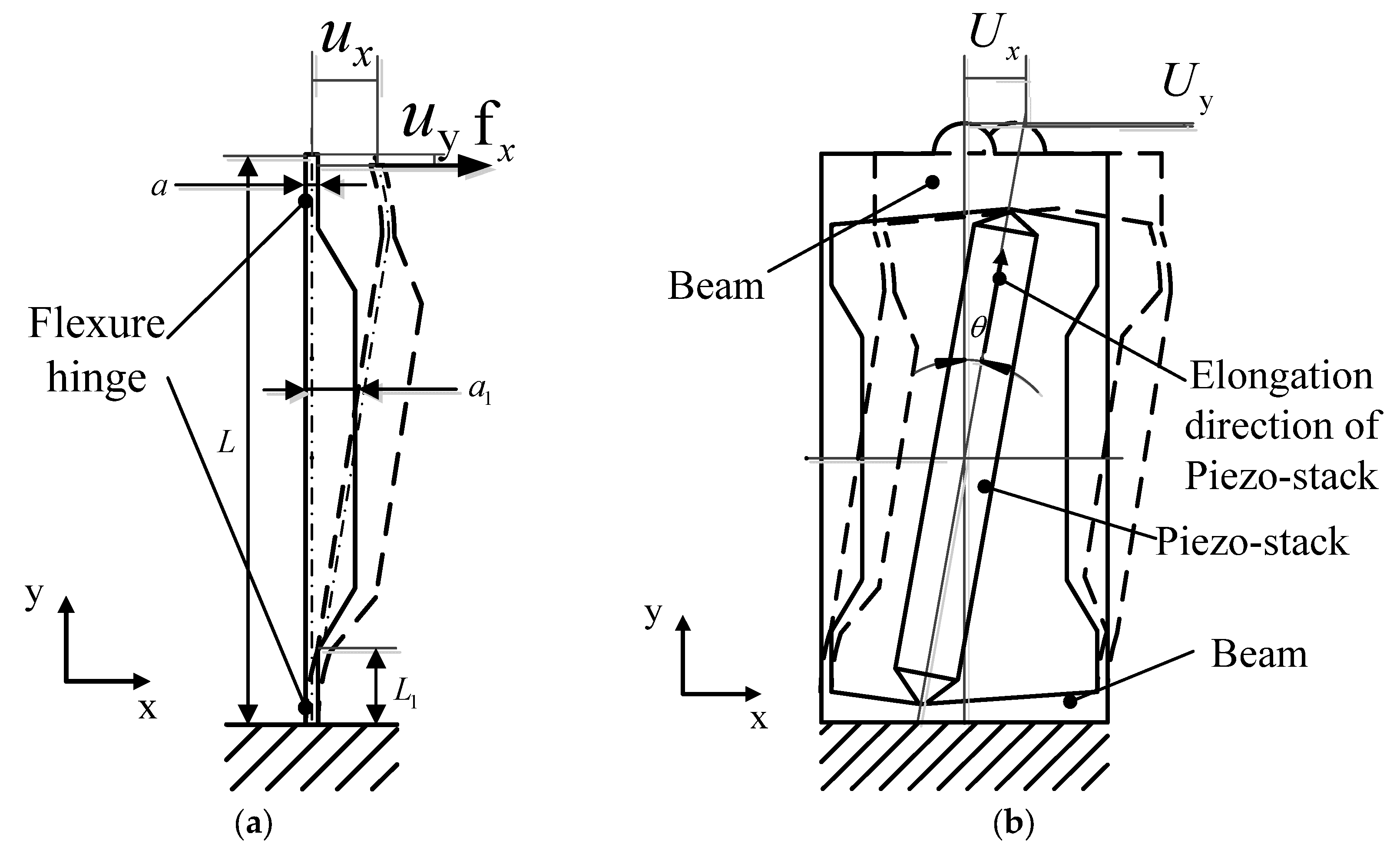
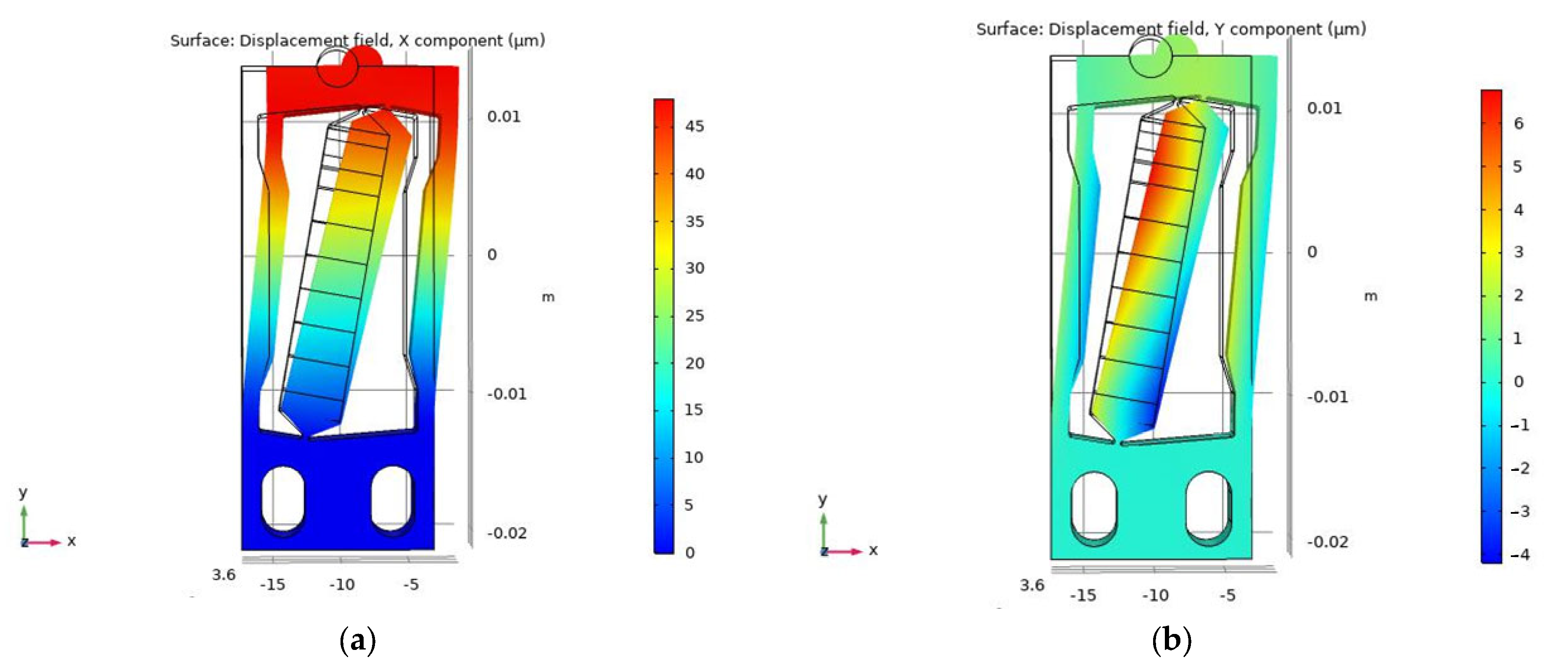

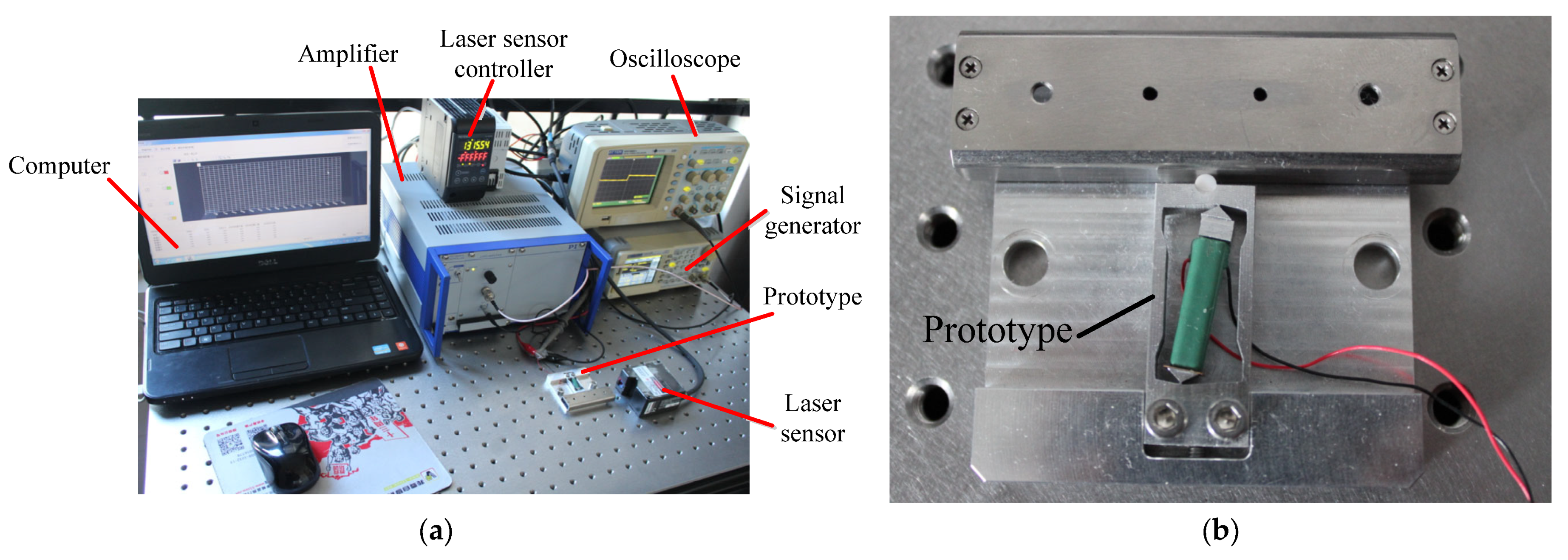
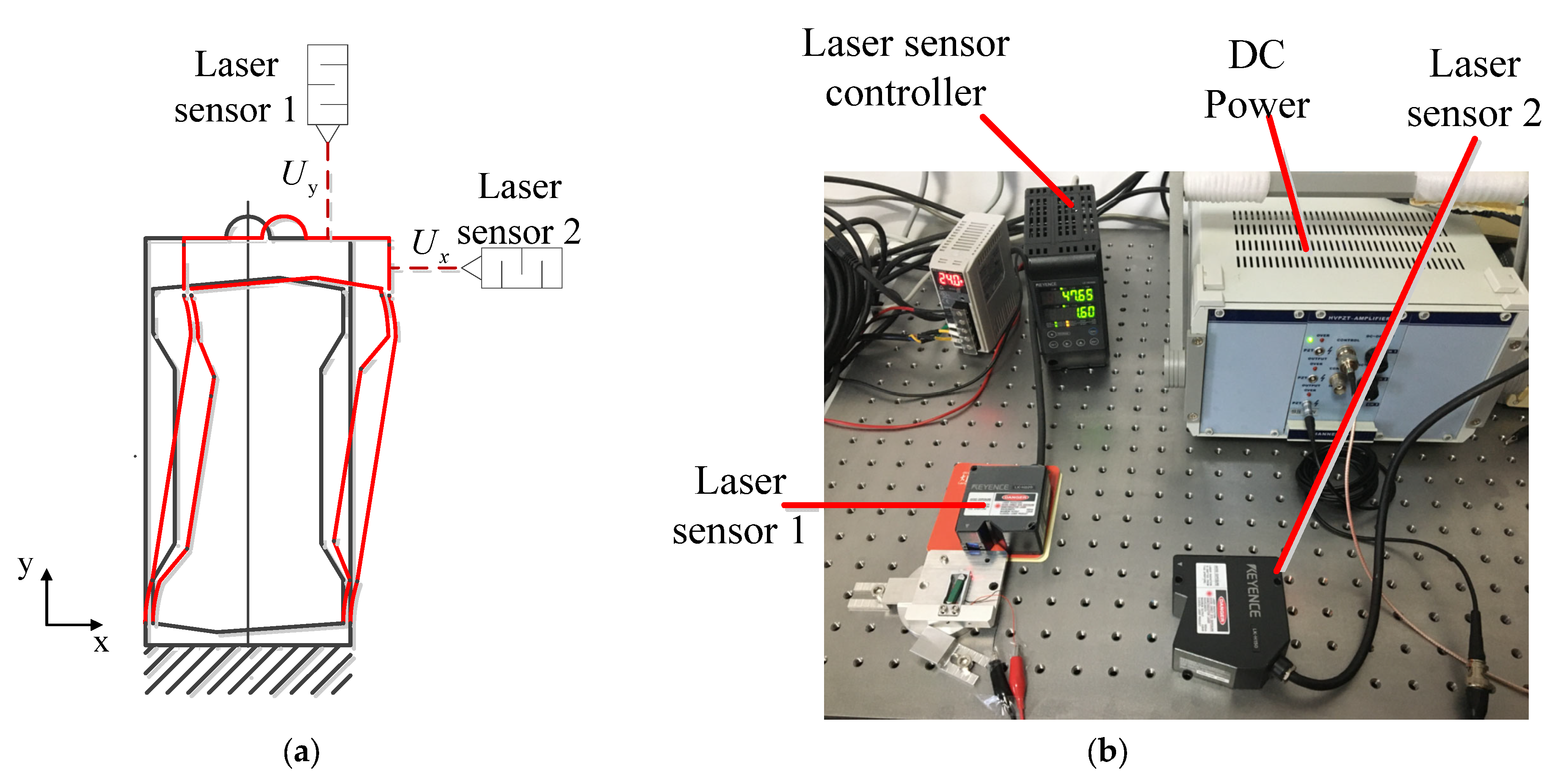
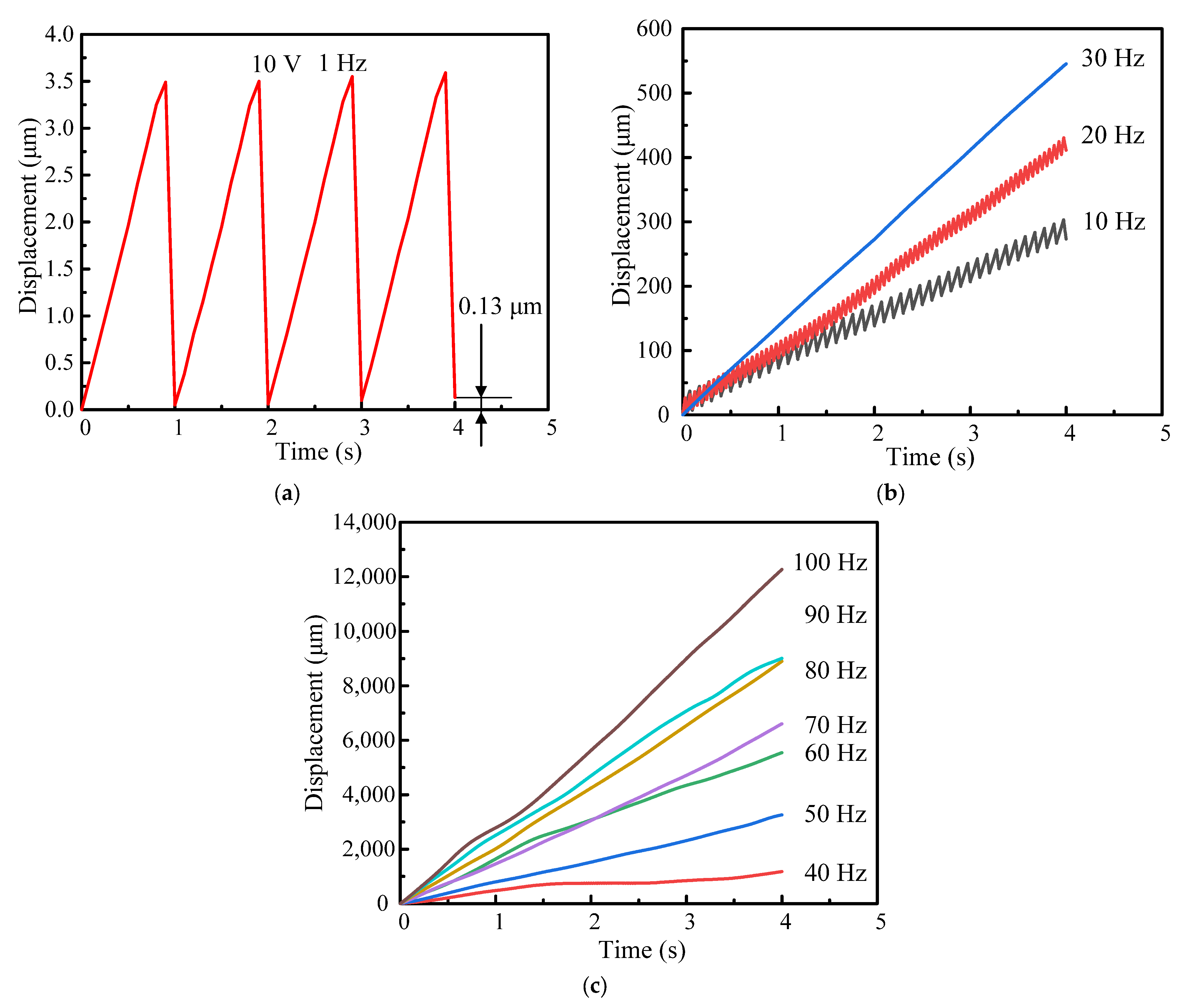


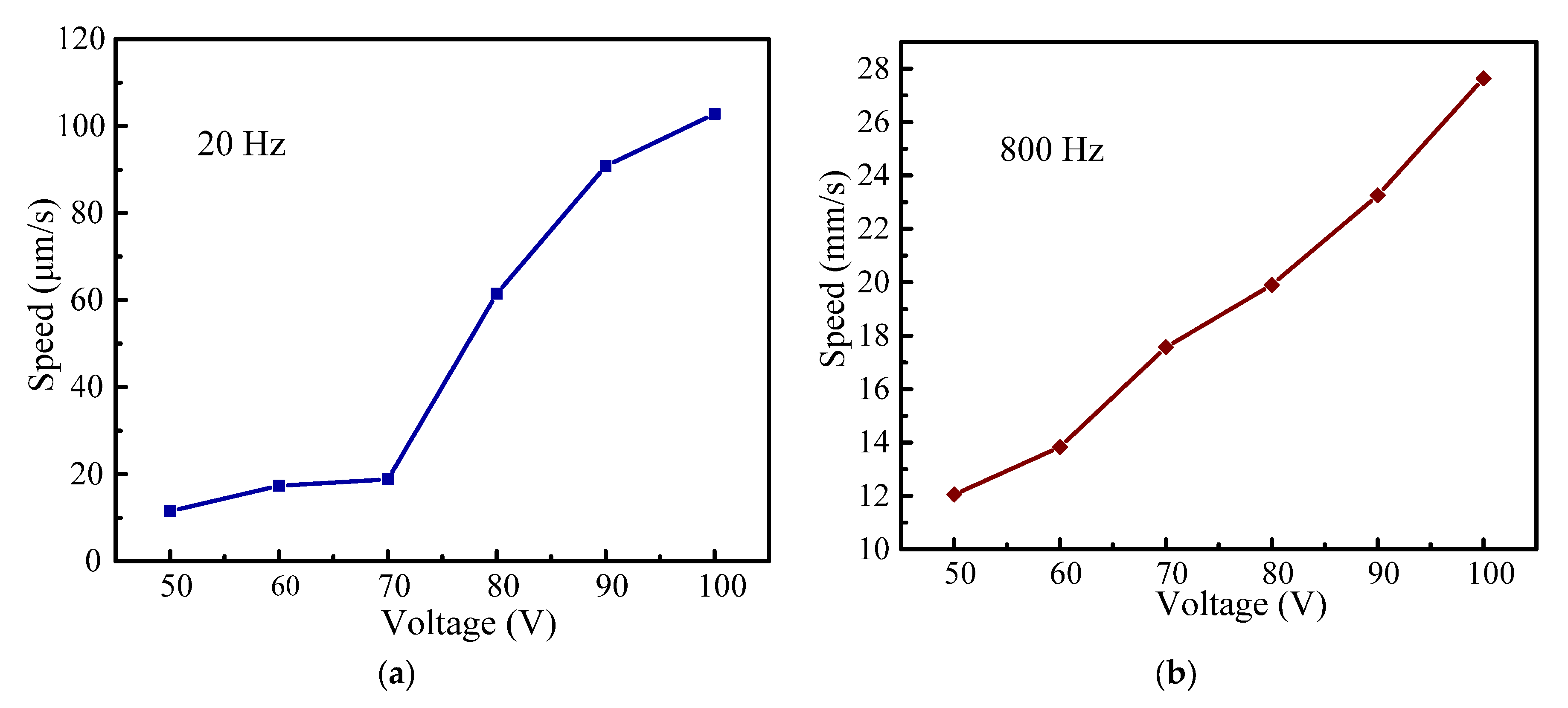
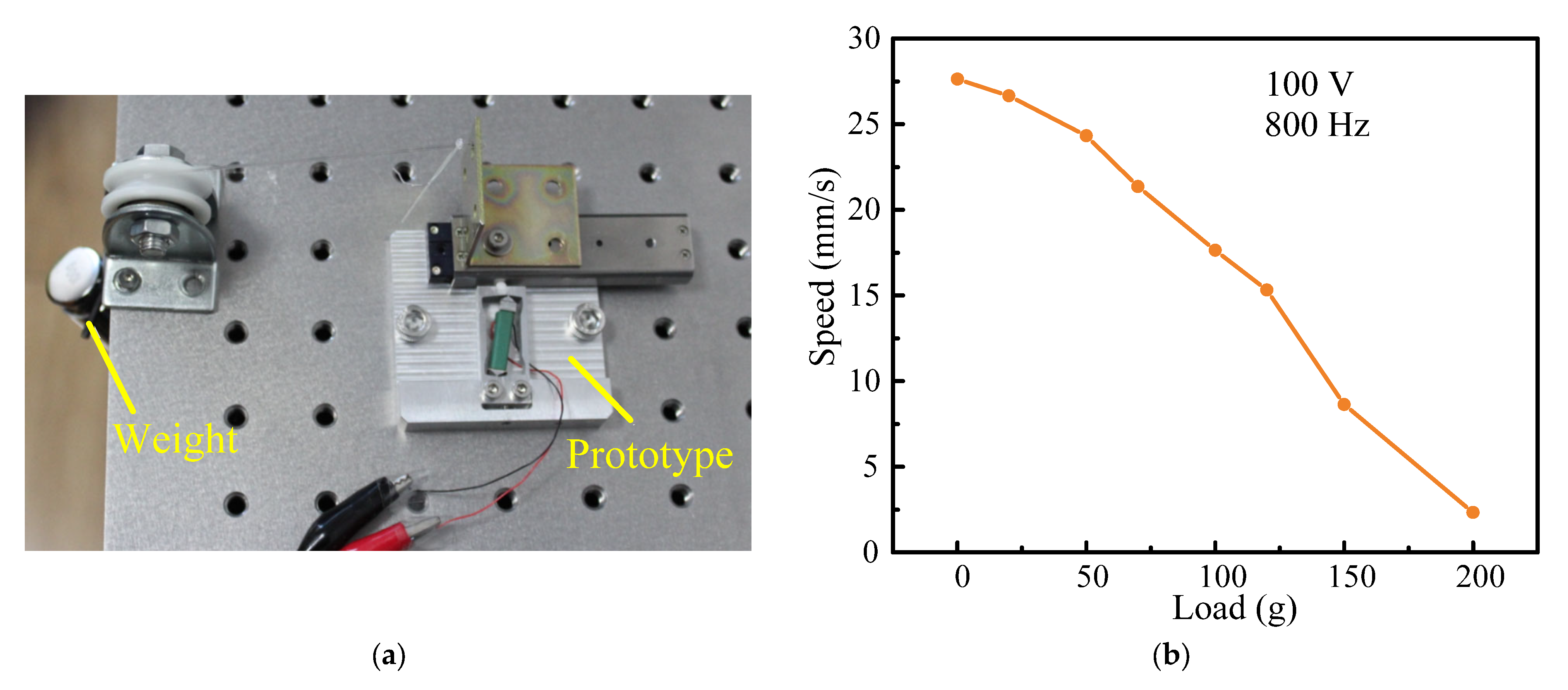
| Material | PZT-5H | Al7075 | ZrO2 |
|---|---|---|---|
| Density(kg/m3) | 7500 | 2810 | 6020 |
| Poisson’s ratio | 0.3 | 0.33 | 0.25 |
| Elastic modulus(×1010 N/m2) | 7.2 | 32 | |
| Piezoelectric constant(C/m2) | / | / | |
| Dielectric constant | / | / |
| Parameter | L | L1 | |||
| Value | 1.2 | 2 | 23 | 3 | 5 |
| Methods | (μm) | (μm) |
| Theoretic analysis | 48.05 | 1.39 |
| FEM | 48.46 | 1.23 |
| Experiment | 47.65 | 1.6 |
| Literature | [15] | [16] | [17,18] | [19] | This Work |
|---|---|---|---|---|---|
| Driving frequency(Hz) | 2000 | 1000 | 700 | 3500 | 800 |
| Driving voltage(V) | 100 | 100 | 100 | 100 | 100 |
| Maximum Speed(mm/s) | 14.25 | 7.12 | 18.37 | 0.7 | 27.077 |
| Resolution(μm) | 0.04 | 0.01 | 0.198 | 0.04 | 0.0325 |
| Load(g) | 350 | 158 | 270 | 4000 | 200 |
| Transverse displacement(μm) | 15.95 | 20.67 | 27.27 | 22 | 47.65 |
| Vertical displacement(μm) | 10 | 10 | / | 11 | 1.6 |
| Displacement ratio (%) | 62.7 | 48.3 | / | 50 | 3.4 |
Disclaimer/Publisher’s Note: The statements, opinions and data contained in all publications are solely those of the individual author(s) and contributor(s) and not of MDPI and/or the editor(s). MDPI and/or the editor(s) disclaim responsibility for any injury to people or property resulting from any ideas, methods, instructions or products referred to in the content. |
© 2023 by the authors. Licensee MDPI, Basel, Switzerland. This article is an open access article distributed under the terms and conditions of the Creative Commons Attribution (CC BY) license (https://creativecommons.org/licenses/by/4.0/).
Share and Cite
Sun, P.; Xu, Z.; Jin, L.; Zhu, X. A Novel Piezo Inertia Actuator Utilizing the Transverse Motion of Two Parallel Leaf-Springs. Micromachines 2023, 14, 954. https://doi.org/10.3390/mi14050954
Sun P, Xu Z, Jin L, Zhu X. A Novel Piezo Inertia Actuator Utilizing the Transverse Motion of Two Parallel Leaf-Springs. Micromachines. 2023; 14(5):954. https://doi.org/10.3390/mi14050954
Chicago/Turabian StyleSun, Pingping, Zhike Xu, Long Jin, and Xingxing Zhu. 2023. "A Novel Piezo Inertia Actuator Utilizing the Transverse Motion of Two Parallel Leaf-Springs" Micromachines 14, no. 5: 954. https://doi.org/10.3390/mi14050954





